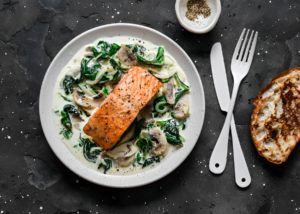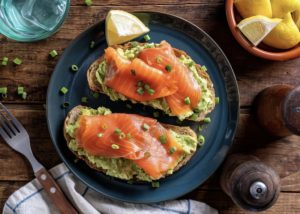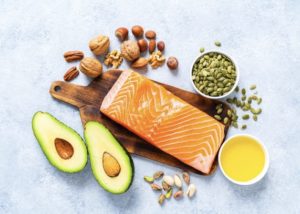- Home
- /
- Healthy Meal
- /
- Healthy meal today
- /
- Breakfast, Lunch, Dinner
- /
- Dinner: Secrets of a...
- /
- Dinner in Healthy Eating:...
- 1. Why Dinner Matters in Healthy Eating
- 2. Nutritional Foundations: What Your Body Needs at Dinner
- 3. Balanced Plates: The Art of Meal Composition
- 4. Mindful Eating: The Psychology of Dinner
- 5. Healthy Dinners in Different Eating Styles
- 6. Healthy Dinner Recipes and Cooking Techniques
- 9. Dinner on the Go: Making Healthy Choices While Dining Out
In the fast-paced world we live in, it’s easy to overlook the importance of dinner in our quest for a healthier lifestyle. Yet, dinner plays a pivotal role in our overall well-being, offering an opportunity to nourish our bodies with essential nutrients while fostering connections with loved ones.
Dinner is the silent hero of our daily culinary story, often playing a pivotal role in shaping our overall well-being. It’s the meal where family and friends gather, where we unwind after a long day, and where we have a chance to nourish both body and soul. Yet, despite its importance, dinner is a subject that doesn’t always receive the attention it deserves in the realm of healthy eating.
In this article, we embark on a journey to discover the profound significance of dinner in the context of a healthy lifestyle. We delve into the nutritional foundations that should underpin our evening meals, explore the art of balanced meal composition, and uncover the psychology behind our dinner choices. From recipes that tantalize the taste buds to strategies for dining out with purpose and intent, we leave no stone unturned in our quest to elevate dinner to its rightful place in the realm of healthy living.
Join us as we uncover the secrets of a nourishing evening, where dinner is not just a meal, but a cornerstone of vibrant health and a celebration of the joyous and mindful connection we share with food. It’s time to give dinner the recognition it deserves in our quest for a healthier, happier life.
1. Why Dinner Matters in Healthy Eating
Dinner is more than just another meal; it is the culmination of your day’s nutritional intake. In this section, we’ll explore why dinner holds such significance in the realm of healthy eating. We’ll discuss how dinner impacts your overall health, energy levels, and even your sleep patterns.
Dinner often occupies a unique place in our daily lives. It’s a time when we come together with family or friends, unwind after a long day, and nourish our bodies before resting. Yet, its significance extends far beyond the social and emotional aspects; dinner plays a pivotal role in the broader context of healthy eating. In this chapter, we explore why dinner matters in the quest for a healthier lifestyle.
1.1. The Significance of Dinner
A. Nutritional Anchor
Dinner serves as the anchor for our daily nutritional intake. It’s the final opportunity to ensure we’ve met our essential nutrient requirements, contributing to the overall balance of our diet. The choices we make at dinner can significantly impact our health.
B. Energy Replenishment
After a day of work, physical activity, and mental exertion, our bodies crave energy. Dinner provides an opportunity to replenish our energy stores and prepare for the upcoming day. Choosing the right foods can help maintain steady energy levels and prevent late-night snacking.
C. Metabolic Support
The body’s metabolism doesn’t shut down at night; it continues to function, albeit at a slower pace. A well-balanced dinner can support this nighttime metabolic activity, aiding in digestion, nutrient absorption, and maintaining a healthy weight.
D. Sleep Quality
What we eat for dinner can significantly impact the quality of our sleep. Certain foods can disrupt sleep patterns, leading to restlessness and fatigue. Conversely, a dinner rich in sleep-supporting nutrients can promote better sleep, ensuring we wake up refreshed.
E. Hormonal Regulation
Dinner influences the release of hormones that control hunger and appetite. Making healthy choices at dinner can help regulate these hormones, preventing overeating and late-night cravings.
About how cortisol affect sleep read in the article: Cortisol and Sleep
1.2. The Role of Dinner in Long-Term Health
A. Chronic Disease Prevention
A well-balanced dinner can contribute to the prevention of chronic diseases such as diabetes, heart disease, and obesity. Consistently making nutritious choices at dinner can have a significant impact on long-term health outcomes.
B. Weight Management
For many individuals, dinner is the largest meal of the day. How we navigate this meal can significantly affect our weight management efforts. A balanced, portion-controlled dinner can aid in weight maintenance or loss.
More about weight management read in the article: Lasting Weight Loss: Intricacies and Pitfalls
C. Mental Health
The foods we choose for dinner can also impact our mental well-being. Nutrient-rich choices can support brain function and mood regulation, promoting mental health and reducing the risk of conditions like depression and anxiety.
More about productivity read in the article: How to keep high level of energy
D. Gut Health
The evening meal can influence gut health, with implications for digestion, immunity, and overall well-being. A dinner rich in fiber and fermented foods can promote a healthy gut microbiome.
1.3. Balancing Dinner in Modern Life
Modern life often presents challenges to maintaining a healthy dinner routine. Busy schedules, takeout options, and social commitments can make it challenging to prioritize nutritious choices. However, understanding the importance of dinner in the broader context of healthy eating can motivate us to overcome these obstacles.
In the following chapters, we’ll delve deeper into the nutritional foundations of dinner, explore strategies for creating balanced dinner plates, and discuss the psychology of dinner choices. Armed with this knowledge, you’ll be better equipped to make dinner a cornerstone of your journey toward a healthier, more vibrant life.
1.4. The role of genetics in product dinner choice
Genetics, an intricate web of inherited traits, also plays a role in our dinner choices. While our DNA doesn’t dictate specific meal preferences, it can influence our sensitivity to tastes and cravings. For instance, some individuals possess a heightened sensitivity to bitter flavors due to certain genetic variations, making them less inclined to enjoy bitter vegetables like Brussels sprouts.
On the flip side, genetic factors can make others more prone to crave sugary or fatty foods, potentially leading to less-than-ideal dinner choices. Understanding these genetic predispositions can empower us to make mindful decisions and personalize our dinner plates to better align with our health goals.
As an example of genes influence on our weight read here: The gene of overweight people: The weight loss strategy
In conclusion, dinner matters not only for its social and emotional significance but also for its profound impact on our physical and mental health. Recognizing the role of dinner in our overall well-being is the first step towards making informed, healthy choices that can transform our lives for the better.
2. Nutritional Foundations: What Your Body Needs at Dinner
Understanding your body’s nutritional requirements is essential for crafting a healthy dinner. We’ll delve into the specific nutrients your body needs during this time of day, including macronutrients (carbohydrates, proteins, and fats) and micronutrients (vitamins and minerals). Additionally, we’ll explore portion control and calorie considerations.
As the sun sets and the day winds down, the choices we make at dinner have a lasting impact on our health and well-being. Dinner is more than just a meal; it’s an opportunity to provide our bodies with the essential nutrients they need to thrive. In this chapter, we’ll delve into the nutritional foundations of dinner, exploring what your body truly requires during this crucial evening repast.
2.1. The Evening Nutrient Blueprint
Dinner serves as the final brushstroke on the canvas of our daily nutrition. To understand what your body needs at this hour, let’s break down the essential components of a balanced dinner:
A. Macronutrients: The Building Blocks
- Proteins: Dinner is an excellent time to include lean proteins. They help repair and build tissues, support immune function, and keep you feeling full longer. Think poultry, fish, beans, tofu, or legumes.
About proteins in details read here: Proteins and Healthy Eating: The Marvels of Molecular Machines
- Carbohydrates: Complex carbohydrates provide a steady source of energy. Opt for whole grains like brown rice, quinoa, or whole wheat pasta. These also contribute fiber for digestive health.
To get known more about carbs follow the link: Demystifying Carbohydrates: Role in Healthy Eating
- Fats: Healthy fats, like those found in avocados, nuts, and olive oil, are essential for absorbing fat-soluble vitamins and supporting various bodily functions.
For getting known more about fats study the article: Fats and Healthy Eating
B. Micronutrients: The Support System
- Vitamins: Dinner is an excellent opportunity to load up on vitamins, particularly A, C, and K, which are important for immune function and bone health. Incorporate a variety of colorful vegetables to cover your vitamin needs.
More itemized info about vitamins here: Vitamins and Healthy Eating: The Enigmatic World
- Minerals: Minerals like calcium, magnesium, and potassium are essential for muscle and bone health, as well as nerve function. Dairy products, leafy greens, and nuts are great sources.
About such useful mineral as magnesium read in the article: Magnesium: The Essential Mineral for Optimal Health
- Antioxidants: Dinner is a chance to flood your body with antioxidants that combat free radicals and reduce the risk of chronic diseases. Berries, spinach, and cruciferous vegetables are packed with antioxidants.
C. Fiber: The Digestive Aid
Fiber is crucial for maintaining digestive health and regulating blood sugar levels. Whole grains, vegetables, and legumes are rich sources of dietary fiber.
D. Water: Hydration Matters
Staying hydrated is important, even at dinner. Adequate water intake aids digestion and helps prevent overeating. Enjoy a glass of water or herbal tea with your meal.
More about water and its characteristic read in the article: Water and the Human Body: The Vital Connection:
2.2. Portion Control and Calorie Awareness
While the focus is on providing your body with the right nutrients, portion control and calorie awareness are equally important. Oversized portions, even of healthy foods, can lead to excess calorie intake. Understanding your body’s calorie needs and portioning your dinner accordingly can help maintain a healthy weight.
2.3. Consider Your Daily Activity
Dinner should also take into account your daily activity level. If you’ve had a sedentary day, your calorie needs will differ from a day filled with physical activity. Adjusting your dinner portion to match your energy expenditure can help you maintain a balanced diet.
About if to count or not to count calorie read here: Calories: To Count or Not to Count?
2.4. Balancing Dinner with Your Lifestyle
Balancing the nutritional foundations of dinner with your lifestyle is key. If you have dietary restrictions or preferences, such as vegetarianism or veganism, it’s important to ensure you’re still getting all the necessary nutrients. Supplements may be necessary in some cases.
In the following chapters, we’ll explore practical strategies for creating balanced dinner plates and discuss the psychology of dinner choices. Armed with a solid understanding of the nutritional foundations of dinner, you’ll be well-prepared to make informed, healthy choices that support your overall well-being. Dinner isn’t just another meal; it’s a chance to nourish your body and set the stage for a healthier tomorrow.
3. Balanced Plates: The Art of Meal Composition
Creating a balanced dinner plate is an art form. We’ll discuss the importance of incorporating a variety of food groups, such as vegetables, lean proteins, whole grains, and healthy fats. You’ll learn about portion sizes, meal timing, and strategies to ensure you’re getting the right nutrients in the right proportions.
About healthy eating plate read in the article: The Principle of the Healthy Eating Plate
Dinner isn’t just about filling your stomach; it’s about nourishing your body with a symphony of nutrients. Crafting a balanced dinner plate is an art form that can help you meet your nutritional needs while savoring the flavors of wholesome ingredients. In this chapter, we’ll explore the principles of meal composition that will enable you to create dinners that are both nutritious and delightful.
To get known about protein-fats-carbs ratio and count the percentage use our Products Calorie Calculator
3.1. The Elements of a Balanced Dinner Plate
Imagine your dinner plate as a canvas, and the ingredients as your palette. To create a masterpiece, you need a harmonious blend of the following elements:
A. Vegetables: The Vibrant Foundation
– Vegetables should form the foundation of your dinner plate. They are rich in vitamins, minerals, fiber, and antioxidants. Aim to fill at least half your plate with colorful vegetables like leafy greens, broccoli, carrots, or bell peppers.
More about vegetables and fruits read in the article: Fruits and Vegetables: Abundant Palette of Healthy Eating
B. Proteins: The Building Blocks
– Proteins are essential for muscle repair, immune function, and overall growth and maintenance. Include a moderate portion of lean protein sources such as grilled chicken, fish, tofu, beans, or legumes.
C. Whole Grains: The Sustaining Core
– Whole grains provide steady, sustained energy. Incorporate a quarter of your plate with options like quinoa, brown rice, whole wheat pasta, or farro. They also contribute fiber for digestive health.
D. Healthy Fats: The Flavor Enhancers
– Healthy fats not only add flavor but also support nutrient absorption and various bodily functions. Include a small portion of sources like avocados, nuts, seeds, or a drizzle of olive oil.
E. Flavorful Extras: The Garnishes and Seasonings
– Elevate your plate with flavorful extras such as herbs, spices, and condiments. These add pizzazz to your meal without excessive calories or sodium.
3.2. Balancing the Plate: Practical Tips
Creating a balanced plate isn’t just about placing different foods together; it’s about understanding portion sizes and nutrient distribution:
- Mindful Portioning: Pay attention to portion sizes, especially with calorie-dense foods like nuts or grains. Measuring cups and visual cues can help you avoid overloading your plate.
- Color Diversity: A colorful plate often signifies a variety of nutrients. Aim for a rainbow of vegetables to ensure you’re getting a wide range of vitamins and antioxidants.
- Protein Choices: Mix up your protein sources to prevent monotony and broaden your nutrient intake. Experiment with plant-based proteins like tempeh or lentils for diversity.
- Whole Grains: Choose whole grains over refined options. They offer more fiber and nutrients, which can keep you feeling full and satisfied.
- Healthy Cooking Methods: Opt for cooking methods that preserve nutrients and reduce the need for excessive fats or oils. Grilling, steaming, roasting, or sautéing with minimal oil are great choices.
More about healthy eating habits read here: Healthy Eating Habits: Nurture Body Correctly
3.3. Adapting Dinner to Your Dietary Preferences
Balancing your dinner plate can be adjusted to various dietary preferences or restrictions, including vegetarian, vegan, low-carb, or gluten-free diets. The key is to maintain the fundamental principles of balanced meal composition while making ingredient substitutions as needed.
In the following chapters, we’ll explore the psychology of dinner choices and various eating styles, offering you even more tools to create dinners that are not only nutritious but also enjoyable. By mastering the art of meal composition, you’ll be well on your way to making dinner a satisfying and health-enhancing experience. Dinner isn’t just a meal; it’s an opportunity to craft a masterpiece on your plate and within your body.
4. Mindful Eating: The Psychology of Dinner
Mindful eating is a crucial aspect of healthy dining. In this section, we’ll delve into the psychological factors that influence our dinner choices. You’ll discover techniques for mindful eating, such as slowing down, savoring each bite, and recognizing hunger and fullness cues.
Dinner is more than a mere act of nourishment; it’s a multisensory experience that engages our emotions, senses, and, perhaps most importantly, our minds. In this chapter, we explore the profound connection between the psychology of dinner and our overall well-being, and how mindful eating can transform your relationship with food.
4.1. The Dinner Table as a Canvas of Sensations
At dinner, we don’t just consume calories; we engage in a sensory journey. The aroma of a freshly cooked dish, the colors on your plate, the textures as you chew, and the interplay of flavors all contribute to the art of dining. To fully appreciate this experience, we must cultivate mindfulness:
A. Slowing Down: Savor Every Bite
– Rushing through dinner deprives you of the opportunity to savor the flavors and textures of your meal fully. Take the time to chew slowly, allowing your taste buds to relish each bite.
B. Engaging the Senses: An Immersive Experience
– The act of dining engages all your senses. Pay attention to the visual appeal of your plate, the aroma of your food, and the sounds of cooking and chewing. Engaging your senses enhances the pleasure of dining.
C. Recognizing Hunger and Fullness
– Mindful eating involves tuning in to your body’s hunger and fullness cues. Before and during dinner, ask yourself if you’re genuinely hungry, and continue checking in during your meal to avoid overeating.
D. Emotional Eating Awareness
– Dinner is often a time when emotions come to the forefront. Be mindful of emotional eating patterns, and ask yourself if you’re eating to soothe emotions or out of genuine hunger.
4.2. The Benefits of Mindful Dinner
Practicing mindfulness at dinner can have profound effects on your relationship with food and your overall health:
A. Weight Management
– Mindful eating can help regulate portion sizes and reduce overeating, contributing to healthy weight management.
More about weight management read here: Lasting Weight Loss: Intricacies and Pitfalls
B. Better Digestion
– Chewing your food thoroughly aids digestion and nutrient absorption. Mindful eating encourages this practice.
C. Enhanced Satisfaction
– Mindful diners often find more satisfaction in their meals, reducing the likelihood of snacking on less healthy options later in the evening.
D. Emotional Well-being
– By addressing emotional eating patterns, mindful dinner practices can promote emotional well-being and stress management.
E. Improved Relationship with Food
– Mindful eating fosters a healthier relationship with food, one that is rooted in enjoyment and nourishment rather than guilt or restriction.
4.3. Cultivating Mindfulness at Dinner
The practice of mindful eating is not something you achieve overnight but rather a skill that develops with time and effort. Here are some practical steps to cultivate mindfulness at dinner
A. Set the Stage
– Create an inviting dinner environment free of distractions. Turn off screens, dim the lights, and set a pleasant atmosphere.
B. Use All Your Senses
– Engage all your senses in the dining experience. Observe the colors, textures, and smells of your food before taking your first bite.
C. Chew Slowly
– Aim to chew each bite thoroughly, savoring the flavors and textures. Put your fork down between bites to help you slow down.
D. Practice Gratitude
– Take a moment to express gratitude for your meal. Reflect on where your food came from and the effort that went into preparing it.
E. Mindful Pauses
– Throughout your meal, pause and check in with your hunger and fullness levels. This can help you avoid overeating.
By incorporating mindful eating practices into your dinner routine, you can transform a simple meal into a profound sensory experience that enhances your overall well-being. Dinner becomes not just a time for sustenance but a moment of connection with your food, yourself, and the present moment. In the following chapters, we’ll explore different eating styles and provide practical recipes and cooking techniques to further enrich your mindful dinner experience.
5. Healthy Dinners in Different Eating Styles
Different dietary philosophies offer unique perspectives on healthy dinner choices. We’ll explore popular eating styles like Mediterranean, vegetarian, and plant-based diets, as well as their potential benefits and considerations. Whether you’re an omnivore or a vegan, there’s a dinner approach that can suit your needs.
One of the beauties of healthy eating is its adaptability. It can be tailored to various dietary philosophies and preferences, accommodating a diverse range of eating styles. In this chapter, we’ll explore how to craft healthy dinners that align with different dietary approaches, from the Mediterranean diet to vegetarian and beyond.
More about diets read here: Decoding Diets: A Short Guide
5.1. Mediterranean Diet: A Symphony of Flavors
The Mediterranean diet is renowned for its health benefits and emphasis on whole, unprocessed foods. A Mediterranean-inspired dinner might include olive oil, vegetables, fruits, whole grains, lean protein, and a dash of red wine. Explore the flavors of Greece, Italy, and Spain with dishes like Greek salad, roasted vegetable ratatouille, or grilled fish with lemon and herbs.
5.2. Vegetarian and Vegan Diets: Plant-Powered Dinners
Vegetarian and vegan diets center around plant-based foods, making dinner a canvas for creativity. Create hearty vegetarian dishes with ingredients like tofu, tempeh, beans, and legumes. Vegan dinners can be equally satisfying with dishes like chickpea curry, quinoa-stuffed bell peppers, or vegan lasagna with cashew-based ricotta.
5.3. Low-Carb Dinners: Balancing Macros
Low-carb eating styles, such as the ketogenic or Atkins diets, limit carbohydrate intake. Healthy low-carb dinners might include grilled chicken with sautéed vegetables, cauliflower rice stir-fry, or zucchini noodles with pesto. These options prioritize protein and healthy fats while reducing carb content.
5.4. Gluten-Free Dinners: Beyond Wheat
For those with gluten sensitivities or celiac disease, gluten-free dinners are a must. Explore gluten-free grains like rice, quinoa, and corn, and use alternatives like almond or coconut flour for breading. Try dishes like gluten-free pasta primavera, rice bowls with teriyaki chicken, or corn tortilla tacos.
5.5. Paleo Diet: Embracing Ancestral Eating
The paleo diet focuses on foods that our ancestors might have eaten, emphasizing whole foods while avoiding grains, legumes, and dairy. Enjoy paleo-friendly dinners with options like grilled grass-fed steak, roasted vegetables, or baked salmon with a side of sweet potatoes.
5.6. Flexitarian Eating: Balancing Choices
Flexitarian eating combines the principles of vegetarianism with occasional meat or fish consumption. Healthy flexitarian dinners can include vegetable-based dishes like stuffed bell peppers or lentil soup, with the occasional inclusion of lean meats or fish.
5.7. Whole Food Plant-Based: Going Beyond Vegan
A whole food plant-based diet takes veganism a step further by emphasizing minimally processed foods. Craft healthy dinners with whole grains, legumes, nuts, seeds, and a variety of fruits and vegetables. Consider dishes like quinoa and black bean bowls, lentil shepherd’s pie, or roasted vegetable platters.
5.8. Pescatarian Diet: Incorporating Seafood
Pescatarians abstain from meat but include seafood in their diet. Healthy pescatarian dinners can feature dishes like grilled salmon with a lemon-dill sauce, shrimp and vegetable stir-fry, or sushi bowls with avocado and brown rice.
5.9. Raw Food Diet: Embracing the Uncooked
The raw food diet consists of unprocessed, uncooked, and mostly organic foods. Explore raw dinner options like zucchini noodles with pesto, raw vegetable wraps with hummus, or colorful salads bursting with nutrients.
5.10. Intermittent Fasting: Timing Matters
Intermittent fasting isn’t about what you eat but when you eat it. Depending on your fasting window, your dinner might need to be rich in nutrients to sustain you through the fasting period. Opt for balanced dinners with a variety of nutrients to support energy and satiety during your fasting hours.
Adapting your dinner to different eating styles requires creativity and an understanding of the principles that govern each approach. By embracing these styles, you can enjoy a diverse range of healthy, flavorful dinners that cater to your dietary preferences and support your overall well-being. In the following chapters, we’ll delve into practical recipes and cooking techniques for each of these eating styles, helping you transform your dinner table into a showcase of culinary diversity and health.
6. Healthy Dinner Recipes and Cooking Techniques
Practicality is key to maintaining a healthy dinner routine. In this section, we’ll provide a collection of nutritious dinner recipes suitable for various dietary preferences. We’ll also delve into cooking techniques that preserve nutrients and flavor while reducing the need for excessive fats and sugars.
Dinner is not just a meal; it’s a culinary adventure waiting to unfold. In this chapter, we’ll dive into the heart of the dinner experience by exploring a variety of healthy dinner recipes and cooking techniques that will make your evenings both nutritious and delicious.
6.1. Grilled Lemon-Herb Chicken with Roasted Vegetables
Ingredients:
– Boneless, skinless chicken breasts
– Lemon juice
– Fresh herbs (rosemary, thyme, or oregano)
– Assorted vegetables (bell peppers, zucchini, cherry tomatoes)
– Olive oil
– Salt and pepper
Technique:
Marinate chicken breasts in lemon juice, fresh herbs, and a drizzle of olive oil for a few hours. Grill the chicken until it’s cooked through and has a delightful char. Roast the vegetables with a sprinkle of salt, pepper, and olive oil until they’re tender. Serve the grilled chicken over a bed of roasted vegetables for a satisfying, healthy dinner.
6.2. Quinoa-Stuffed Bell Peppers
Ingredients:
– Bell peppers (various colors)
– Quinoa
– Black beans
– Diced tomatoes
– Onion
– Garlic
– Cumin, chili powder, and paprika
– Shredded cheese (optional)
Technique:
Prepare quinoa according to package instructions and sauté diced onions, garlic, and spices in olive oil. Mix cooked quinoa, black beans, diced tomatoes, and sautéed onions and garlic. Hollow out bell peppers and stuff them with the quinoa mixture. Bake until the peppers are tender. Top with shredded cheese, if desired, and broil until bubbly.
6.3. Thai-Inspired Vegetable Stir-Fry
Ingredients:
– Assorted vegetables (bell peppers, broccoli, carrots, snap peas)
– Tofu or shrimp (for protein)
– Thai-inspired stir-fry sauce (coconut milk, red curry paste, lime juice, soy sauce)
– Rice or rice noodles
Technique:
Stir-fry your choice of protein until cooked, then set it aside. In the same pan, stir-fry a colorful assortment of vegetables until tender-crisp. Combine the cooked protein, vegetables, and the Thai-inspired stir-fry sauce. Serve over cooked rice or rice noodles for a flavorful, healthy dinner with a hint of exotic flair.
6.4. Lentil and Vegetable Curry
Ingredients:
– Red lentils
– Mixed vegetables (cauliflower, peas, carrots)
– Onion
– Garlic
– Ginger
– Curry spices (turmeric, cumin, coriander)
– Coconut milk
Technique:
Sauté diced onion, garlic, and ginger in a large pot. Add curry spices and toast them for a minute. Stir in red lentils, mixed vegetables, and coconut milk. Simmer until the lentils are tender and the vegetables are cooked through. Serve with basmati rice or naan for a comforting, protein-rich dinner.
6.5. Mediterranean Chickpea Salad
Ingredients:
– Chickpeas (canned or cooked)
– Cucumber
– Cherry tomatoes
– Red onion
– Kalamata olives
– Feta cheese
– Fresh herbs (parsley, mint)
– Olive oil and lemon juice
Technique:
Combine chickpeas, diced cucumber, halved cherry tomatoes, sliced red onion, pitted Kalamata olives, crumbled feta cheese, and chopped fresh herbs in a bowl. Drizzle with olive oil and lemon juice, then season with salt and pepper. Toss to combine for a refreshing, Mediterranean-inspired salad that can serve as a hearty dinner.
6.6. Cooking Techniques for Healthier Dinners
In addition to these recipes, consider incorporating these cooking techniques into your dinner preparation:
- Steaming: Steaming retains nutrients in vegetables and proteins while enhancing flavor. Try steamed broccoli or fish with a squeeze of lemon.
- Baking and Roasting: Baking and roasting are excellent for creating crispy textures without excessive oil. Roasted sweet potatoes, Brussels sprouts, or salmon fillets are delicious and nutritious options.
- Stir-Frying: Stir-frying with a minimal amount of oil cooks ingredients quickly and preserves their natural flavors and textures. It’s ideal for dishes like vegetable stir-fries or tofu with Asian-inspired sauces.
- Poaching: Poaching proteins like chicken or fish in flavorful liquids, such as broth or wine, keeps them tender and infuses them with subtle flavors.
- One-Pot Meals: One-pot meals, like hearty soups or stews, are not only convenient but also allow flavors to meld, resulting in rich, satisfying dinners.
These recipes and techniques provide a foundation for crafting healthy dinners that are not only nourishing but also a pleasure to savor. Experiment with ingredients, flavors, and cooking methods to discover your own signature healthy dinner creations. In the following chapters, we’ll explore dinner options for special diets and delve into the social and cultural aspects of healthy dining, offering you a rich tapestry of culinary possibilities.
9. Dinner on the Go: Making Healthy Choices While Dining Out
Eating dinner at home is ideal, but life often takes us out to restaurants or other people’s homes. This section offers tips and strategies for making healthy choices when dining out, from reading menus wisely to managing portion sizes.
In our fast-paced world, dining out is a common occurrence. Whether it’s for business meetings, social gatherings, or convenience, eating at restaurants can present challenges to maintaining a healthy dinner routine. In this chapter, we’ll explore strategies and tips for making mindful and nutritious choices while dining out.
9.1. The Dining Out Dilemma
Eating out can be a delightful experience, but it often presents temptations that can derail your healthy eating goals:
A. Tempting Menus
– Restaurant menus often feature enticing dishes that are high in calories, saturated fats, and sugars.
B. Oversized Portions
– Restaurants frequently serve larger portions than you might eat at home, making it easy to consume more calories than you need.
C. Hidden Ingredients
– Many restaurant dishes contain hidden ingredients that contribute to excessive sodium, sugar, and unhealthy fats.
D. Social Pressure
– Dining out with friends or colleagues may lead to social pressure to indulge in less healthy options.
9.1. Strategies for Healthy Dining Out
Despite these challenges, it’s entirely possible to enjoy dining out while making healthy choices:
A. Plan Ahead
– Check the restaurant’s menu online before you go. Look for dishes that align with your dietary preferences and health goals.
B. Control Portions
– Consider sharing an entree with a dining companion or ask for a to-go box at the beginning of the meal to portion out leftovers.
C. Mindful Ordering
– Opt for grilled, steamed, or baked dishes over fried or breaded options. Choose lean proteins and ask for dressings or sauces on the side.
D. Beware of Hidden Ingredients
– Ask your server about ingredients that might not be listed on the menu. Be mindful of excessive salt, sugar, and unhealthy fats.
E. Hydrate Wisely
– Choose water or unsweetened beverages instead of sugary sodas or alcoholic drinks, which can add unnecessary calories.
F. Substitute Smartly
– Inquire about healthier substitutes, such as swapping out fries for a side salad or requesting whole-grain bread.
G. Enjoy Mindfully
– Slow down and savor your meal. Pay attention to hunger cues and stop eating when you’re satisfied.
H. Be Assertive
– Don’t be afraid to customize your order. Most restaurants are willing to accommodate dietary requests.
J. Dessert Decision
– If you want dessert, consider sharing it with the table or ordering a smaller portion.
I. Social Support
– Inform your dining companions about your healthy eating goals so they can offer encouragement and support.
9.2. Cuisine-Specific Strategies
Different types of restaurants present unique challenges and opportunities for healthy dining:
A. Italian
– Choose tomato-based sauces over cream-based ones. Opt for whole-grain pasta and ask for a side of vegetables.
B. Mexican
– Go for dishes with grilled proteins, like fajitas. Be mindful of portion sizes and consider skipping the chips and queso.
C. Asian
– Choose stir-fried or steamed dishes with plenty of vegetables. Be cautious with high-sodium sauces and fried options.
D. Fast Food
– Look for salads, grilled chicken sandwiches, or wraps with plenty of veggies. Avoid super-sized meals and sugary beverages.
E. Buffets
– Focus on salad greens, lean proteins, and non-starchy vegetables. Limit your trips to the buffet to control portion sizes.
Healthy dining out is all about balance and making informed choices that align with your health goals. By employing these strategies, you can savor the experience of dining out while prioritizing your well-being. In the final chapter, we’ll recap the key takeaways from this comprehensive guide and emphasize the importance of making dinner a cornerstone of your healthy lifestyle.
The Journey Towards Healthier Dinners
Throughout this exploration of dinner in the realm of healthy eating, we’ve unearthed a treasure trove of insights, strategies, and culinary wonders. It has come to understand that dinner is far more than just a meal; it’s a canvas upon which we paint our daily nutrition, a stage for the interplay of flavors and textures, and a moment of mindful connection with both ourselves and others.
We’ve dived into the nutritional foundations that should form the bedrock of our dinner plates, recognizing the importance of macronutrients, micronutrients, fiber, and hydration in crafting nourishing meals. We’ve mastered the art of balanced meal composition, learning to create dinner plates that harmonize colors, flavors, and nutritional elements to delight the senses and fuel the body.
Conclusion
Our journey has taken us deep into the psychology of dinner, where we’ve embraced the concept of mindful eating as a means to fully appreciate the sensory journey of each bite and to foster a healthier relationship with food. We’ve discovered how dinner can transcend the realm of sustenance to become a moment of connection, strengthening familial bonds, kindling friendships, and honoring cultural traditions.
When we venture outside our homes for dinner, we’ve equipped ourselves with strategies to navigate restaurant menus, control portion sizes, and make mindful choices that align with our health goals. We’ve celebrated the diversity of cuisines, acknowledging that dinner on the go can be both nutritious and enjoyable.
As we conclude our culinary odyssey, it’s clear that dinner holds a unique place in the landscape of healthy eating. It’s a time to savor the present moment, to appreciate the artistry of nourishing our bodies, and to share the joy of food with loved ones.
So, let us leave you with this: may your dinners be not just a routine, but a ritual—a celebration of health, a testament to the joy of flavors, and a reflection of the love and care you invest in your well-being. As you sit down to your next dinner, remember that it’s not just a meal; it’s an opportunity to savor life itself. Bon appétit, and may your dinner tables always be filled with health, happiness, and harmony.
































































0 Comments